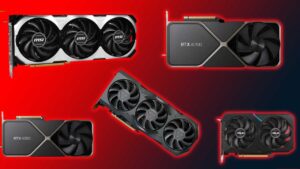Introduction:
RISC-V, an open-source instruction set architecture (ISA), has been gaining significant traction in recent years, offering a promising alternative to traditional proprietary architectures. In this blog post, we’ll delve deeper into the RISC-V ecosystem by exploring 5 companies that are making waves with their innovative approaches and solutions.
Follow us on Linkedin for everything around Semiconductors & AI
Why is RISC-V Important?
RISC-V (pronounced “risk-five”) is an open-source instruction set architecture (ISA) for processors. Unlike traditional ISAs controlled by a single company, RISC-V is freely available for anyone to use and modify. This openness makes it significant for a few reasons:
- Flexibility and Customization: RISC-V’s modular design allows for creating custom processors for specific applications. This can lead to more efficient chips that use less power or excel at particular tasks.
- Openness Fosters Innovation: Anyone can contribute to the development of RISC-V, which speeds up innovation and collaboration across the tech industry.
- Lower Costs: Because RISC-V is royalty-free, it can potentially reduce the cost of chip development and production.
- Security: The open nature of RISC-V allows for more scrutiny and community-driven security improvements.
RISC-V is still in its early stages, but it has the potential to be a major player in the future of processor design, especially in areas like:
- Internet of Things (IoT): The low-power and customization benefits make RIS-V ideal for small, battery-powered devices.
- Artificial Intelligence (AI): Custom RISC-V cores can be tailored for specific AI applications.
- High-Performance Computing (HPC): Scalable RISC-V designs could power future supercomputers.
Overall, RISC-V’s open and flexible nature is shaking up the traditional ISA market and holds promise for innovation across various technological sectors.
Top 5 RISC-V Companies: Strengths and Moats
1. SiFive:
Strengths:
- Customizable CPU IP solutions tailored to diverse application needs, ranging from embedded systems to high-performance computing.
- Comprehensive suite of RISC-V cores, including the E3, E5, and U7 series, offering scalability, configurability, and compatibility with industry standards.
- SiFive Core Designer toolchain, enabling developers to design, simulate, and implement custom RISC-V cores efficiently.
Moat:
- Extensive experience and expertise in RISC-V architecture and development, with a team comprised of industry veterans and RISC-V pioneers.
- Strong customer base across various industries, including IoT, automotive, and aerospace, built on reputation and reliability.
- Strategic partnerships with leading semiconductor companies, fostering innovation and collaboration in the RISC-V ecosystem.
Read More: Top 5 Upcoming Apple Products for the Next Decade – techovedas
2. Andes Technology:
Strengths:
- High-performance, low-power CPU IP solutions catering to different use cases, from edge devices to data centers, with the N25 and D25 series.
- Innovation and customization capabilities, enabling optimal performance and efficiency for specialized applications such as AI, IoT, and automotive.
- Extensive portfolio of RISC-V cores, including the AndesCore™ series and specialty cores like the AE250, offering flexibility, scalability, and security features.
Moat:
- Focus on research and development, driving continuous improvement and innovation in RISC-V architecture and processor design.
- Strategic partnerships and collaborations with academia, research institutions, and industry consortia, expanding market reach and influence.
- Strong presence in key markets like China, Taiwan, and the United States, supported by a global network of sales and support offices.
Read More: 80% Home Tools by 2024: “Father of China’s Chip Equipment” Leads Domestic Blitz – techovedas
3. Western Digital:
Strengths:
- Integration of RISC-V cores into storage controllers and SSDs, enhancing performance, reliability, and data integrity in data storage systems.
- Embrace of open architectures, reducing dependency on proprietary technologies and enabling greater interoperability and compatibility.
- Commitment to standards-based solutions, fostering collaboration and innovation in the RISC-V ecosystem through initiatives like the OpenTitan project.
Moat:
- Leadership position in the storage industry, leveraging brand reputation, market presence, and customer trust.
- Investment in RISC-V ecosystem development, including contributions to open-source projects and partnerships with RISC-V organizations and communities.
- Vision for a more open, collaborative, and secure future for computing, driven by RISC-V and open standards.
Read More: What’s the Dynamic Relationship Between Elon Musk’s Ventures and NVIDIA – techovedas
4. Esperanto Technologies:
Strengths:
- Development of RISC-V-based AI accelerators for demanding machine learning workloads, leveraging the ET-Minion™ architecture and ET-Synthetix™ software stack.
- Custom-designed AI chips optimized for performance, efficiency, and scalability, addressing the growing demand for AI hardware solutions in data centers and edge devices.
- Focus on open architectures and software ecosystems, enabling seamless integration with popular AI frameworks like TensorFlow and PyTorch.
Moat:
- Unique expertise in AI hardware design, leveraging RISC-V architecture for competitive advantage in power efficiency, flexibility, and customization.
- Collaboration with industry leaders and research institutions, driving innovation and differentiation in AI chip technology.
- Vision for democratizing AI computing and accelerating AI adoption across industries through affordable, accessible, and scalable AI solutions.
5. GreenWaves Technologies:
Strengths:
- Ultra-low-power IoT processors powered by RISC-V cores, targeting battery-operated edge devices in applications like sensor networks, smart agriculture, and wearables.
- Advanced processing capabilities for sensor fusion, audio processing, and machine learning at the edge, enabling real-time inferencing and decision-making without cloud connectivity.
- Focus on power-efficient processing, achieved through innovative design techniques, including asynchronous processing and heterogeneous computing architectures.
Moat:
- Specialization in energy-efficient IoT solutions, providing a competitive edge in the market for battery-powered and resource-constrained devices.
- Strong focus on research and development, driving product innovation and differentiation in IoT processor technology.
- Strategic partnerships with sensor manufacturers, IoT platform providers, and system integrators, expanding market reach and enabling end-to-end IoT solutions.
Read More: Why Cognitive Computing is Considered Future of Artificial Intelligence – techovedas
Conclusion:
With their unique strengths, capabilities, and competitive advantages, 5 startups like SiFive, Andes Technology, Western Digital, Esperanto Technologies, and GreenWaves Technologies are poised to lead the RISC-V revolution. By leveraging their expertise, innovation, and strategic positioning, these companies are driving the adoption and proliferation of RISC-V across various industries, reshaping the future of computing and accelerating the transition to open, collaborative, and customizable architectures.




